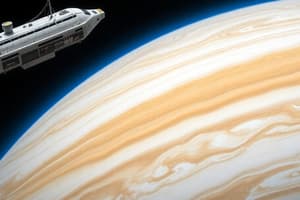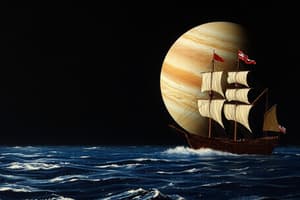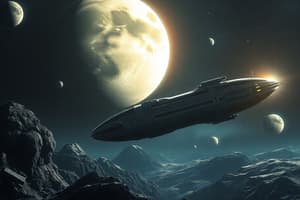Podcast
Questions and Answers
What is Europa primarily made of?
What is Europa primarily made of?
- Water ice
- Sodium chloride
- Silicate rock (correct)
- Iron-nickel core
What is the predominant model for the existence of a subsurface ocean on Europa?
What is the predominant model for the existence of a subsurface ocean on Europa?
- Heat from tidal flexing (correct)
- Heat from radioactive decay
- Heat from the sun
- Heat from atmospheric pressure
What is the estimated thickness of Europa's icy crust?
What is the estimated thickness of Europa's icy crust?
- 1-10 km
- 50-70 km
- 30-50 km
- 10-30 km (correct)
What is the primary component of Europa's thin atmosphere?
What is the primary component of Europa's thin atmosphere?
What is the estimated age range of Europa's surface?
What is the estimated age range of Europa's surface?
What is the primary source of heat for Europa's subsurface ocean?
What is the primary source of heat for Europa's subsurface ocean?
What is the estimated depth of Europa's subsurface ocean?
What is the estimated depth of Europa's subsurface ocean?
What is the name of the European Space Agency's planned mission to Europa?
What is the name of the European Space Agency's planned mission to Europa?
What is the estimated temperature range on Europa's surface?
What is the estimated temperature range on Europa's surface?
Flashcards
Europa
Europa
Smallest of Jupiter's Galilean moons, primarily silicate rock with a water-ice crust and potential iron-nickel core.
Europa's Surface
Europa's Surface
Europa's surface has light tan cracks and streaks, but relatively few impact craters
Tidal Flexing
Tidal Flexing
Process where heat from Jupiter's gravity keeps Europa's subsurface ocean liquid, driving ice movement like plate tectonics.
Lineae
Lineae
Signup and view all the flashcards
Europa's Heat Sources
Europa's Heat Sources
Signup and view all the flashcards
Oxygen Atmosphere
Oxygen Atmosphere
Signup and view all the flashcards
Radiolysis
Radiolysis
Signup and view all the flashcards
High Radiation
High Radiation
Signup and view all the flashcards
Lithopanspermia
Lithopanspermia
Signup and view all the flashcards
Study Notes
Europa: Jupiter's Smallest Galilean Moon
- Europa is the smallest of the four Galilean moons orbiting Jupiter and the sixth-closest to the planet of all the 95 known moons of Jupiter.
- It is primarily made of silicate rock and has a water-ice crust and probably an iron–nickel core.
- Europa has a very thin atmosphere, composed primarily of oxygen.
- Europa's surface is striated by light tan cracks and streaks, but craters are relatively few.
- Europa's smooth surface and apparent youth have led to the hypothesis that a water ocean exists beneath the surface, which could harbor extraterrestrial life.
- The predominant model suggests that heat from tidal flexing causes the ocean to remain liquid and drives ice movement similar to plate tectonics.
- Sea salt from a subsurface ocean may be coating some geological features on Europa, suggesting that the ocean is interacting with the sea floor.
- The Hubble Space Telescope detected water vapor plumes similar to those observed on Saturn's moon Enceladus, which are thought to be caused by erupting cryogeysers.
- There have been several proposed exploration missions to Europa, with the European Space Agency's Jupiter Icy Moon Explorer (JUICE) and NASA's Europa Clipper expected to launch in 2023 and 2024, respectively.
- Europa's surface is about 20 to 180 million years old, based on estimates of the frequency of cometary bombardment that Europa experiences.
- Europa's most striking surface features are a series of dark streaks crisscrossing the entire globe, called lineae (English: lines).
- The scientific consensus is that a layer of liquid water exists beneath Europa's surface, and that heat from tidal flexing allows the subsurface ocean to remain liquid.Europa: Composition, Sources of Heat, Atmosphere, Climate and Weather
Composition:
- Europa has a thin icy crust, estimated to be 10-30 km thick, and a subsurface ocean estimated to be about 100 km deep
- The ocean is believed to be salty and a possible source of electrically conductive material that generates a weak magnetic moment
- Europa's reddish-brown material on the surface is rich in salts and sulfur compounds, and may contain abiotic organic compounds called tholins
- Sodium chloride has been detected in Hubble observations of the chaos regions, suggesting the presence of a subsurface ocean
Sources of Heat:
- Europa receives thermal energy from tidal heating and radioactive decay within the rocky mantle
- Tidal heating occurs through tidal friction and tidal flexing processes, which generates heat in the core, ocean, and ice crust
- Tidal flexing can generate one order of magnitude more heat in Europa's ice than previously assumed, and could drive hydrothermal activity
- Plumes of water vapor have been observed on Europa, which may indicate the presence of hydrothermal vents and a potential source of heat for the subsurface ocean
Atmosphere:
- Europa has a thin and tenuous atmosphere primarily composed of oxygen and trace amounts of water vapor, created through radiolysis and the dissociation of molecules through radiation
- The atmosphere forms a neutral torus around Europa's orbital plane, and has a greater content than the neutral cloud surrounding Jupiter's inner moon Io
- Europa's atmosphere requires continuous replenishment due to the constant release of hydrogen-oxygen mixture into space, which confirms the presence of a conductive element likely to be a subsurface ocean
Climate and Weather:
-
Europa has no weather producing clouds, wind, or precipitation due to its low gravity that cannot hold a substantial atmosphere
-
Europa's temperature varies from -160°C at the equatorial line to -220°C at the poles, but the subsurface ocean is believed to be warm due to tidal heating and radioactive decay
-
Europa's ocean is thought to be acidic, based on theoretical considerations of tidal heating and the presence of sulfur compounds on the surfaceExploration and Future Missions to Europa
-
Europa's ocean contains high concentrations of chloride, resembling Earth's oceans.
-
Pioneer 10 and 11 provided the first images of Europa's surface, followed by more detailed images from the Voyager probes in 1979.
-
The Galileo spacecraft orbited Jupiter for eight years, providing the most detailed examination of Europa to date.
-
Future missions to Europa aim to examine its chemical composition and search for extraterrestrial life in its hypothesized subsurface oceans.
-
Europa missions must endure high levels of radiation, with Europa receiving about 5.40 Sv of radiation per day.
-
The U.S. Planetary Science Decadal Survey recommended a Europa mission in 2011, leading to Europa lander concept studies and concepts for a Europa flyby and orbiter.
-
Past proposals for missions to Europa include the Jupiter Europa Orbiter, Jupiter Ganymede Orbiter, Ice Clipper, Jovian Europa Orbiter, Jupiter Icy Moons Orbiter, and Europa Lander Mission.
-
Europa's under-ice ocean may be habitable, with similarities to Earth's deep-ocean hydrothermal vents.
-
Evidence suggests the existence of lakes of liquid water entirely encased in Europa's icy outer shell, as well as pockets of water that form M shaped ice ridges when the water freezes on the surface.
-
Hydrogen peroxide may be an important energy supply for simple life forms on Europa.
-
Clay-like minerals, often associated with organic matter on Earth, have been detected on the icy crust of Europa.
-
Some scientists have speculated that life on Earth could have been blasted into space by asteroid collisions and arrived on the moons of Jupiter in a process called lithopanspermia.
Studying That Suits You
Use AI to generate personalized quizzes and flashcards to suit your learning preferences.





